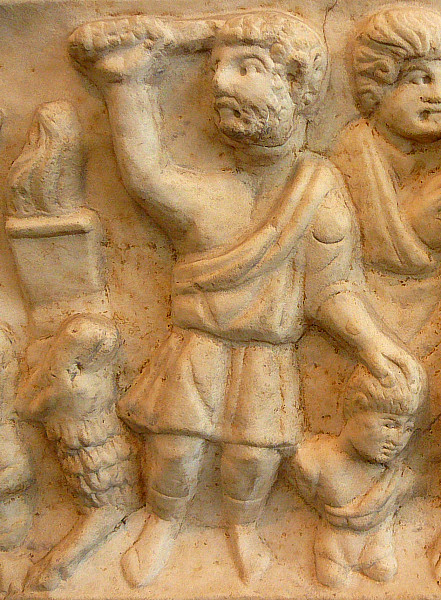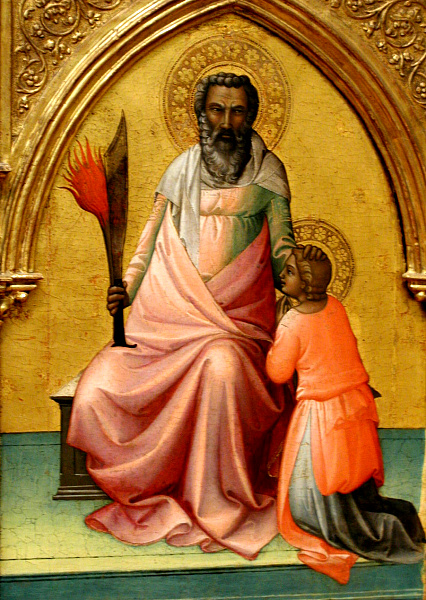NARRATIVE IMAGES
Most narrative images involving Abraham will relate episodes in his story to the Eucharist.Abram and Melchizedek
After Abram prevails in a battle to rescue his nephew Lot, Genesis 14:18-20 introduces a mysterious "king of Salem…priest of the most high God" who blesses Abram with a sacrifice of bread and wine (image). Christian commentators took Melchizedek to be a type of Christ and his sacrifice to be a foreshadowing of the Eucharist.1 The Melchizedek mosaic in Sant'Apollinare in Clase associates his sacrifice with those of Abel and Abraham, all of them being types of Christ's sacrifice and thence of its memorial, the Eucharist. Another narrative genre with Eucharistic import is the Sacrifice of Isaac, Abraham's response to God's demand that he sacrifice his son (Genesis 22:1-14), which early commentators took to be a foreshadowing of the sacrifice of Christ on the cross.2 Abraham's sacrifice is illustrated in the first two pictures on the right and provides the elements for the portrait of Abraham in the third picture at right: Isaac himself, the sword, and the fire used for the sacrifice.Even as early as the beginning of the 3rd century, the art emphasizes the connection between Abraham's sacrifice and the remembrance of Christ's sacrifice in the liturgy (example). In medieval times it continued to be a major topic in the art (example) and in the literature.
Sarcophagi reliefs of the 4th century tend to show the sacrifice scene at just the moment when God stays Abraham's hand (example). Such scenes are more consistent with the general tenor of the images on the sarcophagi, which emphasize faith, forgiveness, and salvation. The scenes are often paired with images of the same hand giving the Law to Moses, the two men placed on either side of the decedent's image (example). This kind of scene is very common in the 4th century, as in the sarcophagi listed at right.
The Hospitality of Abraham
In Genesis 18:1-15 three persons visit Abraham and predict the birth of Isaac. The commentators took the three to be God himself, revealing himself as the Trinity. See our page for the Trinity.Other Episodes
In Genesis 21:14-19 Abraham dismisses his servant Hagar and her baby, Ishmael. They wander in the wilderness and eventually the water Abraham had given them runs out, but an angel comes and directs them to a spring. Augustine interprets the spring as Christ and relates it to John 7:37, "Whoever thirsts, let him come to me and drink" (Glossa Ordinaria, I, 259). In a painting in Palermo's Norman Palace the angel directs Hagar's attention toward the spring.In his Antiquities of the Jews (I, viii, §2) Josephus states that while Abraham was in Egypt (Genesis 12:10-20) he taught the science of Astronomy to the scholars there. This is the subject of a painting by Antonio Zanchi.
PORTRAITS
Other than his having a beard, there is very little consistency in the portraits of Abraham. In some of them the sacrifice of Isaac will function as an attribute (example). In Morlaiter's sculpture the attributes are firewood and a sword.In the Last Judgment tympanum at Conques only three persons sit on thrones. In the center of the middle register Christ presides over the final judgment. In the right segment of the lower register Satan presides over the damned, while in the left segment Abraham sits with his sons as "father in faith" (Romans 4:13-16) of all the just.
ABRAHAM IN SCRIPTURE
Genesis tells Abraham's story in chapters 11 through 20. Matthew 1:2 opens Jesus' genealogy with Abraham. Galatians 3:7-18 and Hebrews 11:8-12 relate his trust in God to the concept of justification by faith. Conversely, James 2:20-24 makes him an exemplar of one whose faith was useless without his works.
Prepared in 2014 by Richard Stracke, Emeritus Professor of English, Augusta University.
HOME PAGE
The earliest known image of the sacrifice of Isaac, at the 3rd-century synagogue in Dura-Europos, Syria. (See the description page.)

Detail from a 4th-century sarcophagus with the Sacrifice of Isaac (See the description page.)

Lorenzo Monaco, Abraham, circa 1408/1410 (See description page)
IMAGES ON SARCOPHAGI
- Sarcophagus of Marcus Claudianus, Palazzo Massimo, Rome
- Sarcophagus of the Two Brothers, Museo Pio Cristiano, Rome
- Sarcophagus Lid from the Cemetery of Callixtus, Museo Pio Cristiano, Rome
- Sarcophagus of Agape and Crescentianus, Museo Pio Cristiano, Rome
- Double-register Sarcophagus, inventory 31546, Museo Pio Cristiano, Rome
- Sarcophagus, inventory 31551, Museo Pio Cristiano, Rome
- Sarcophagus of Adelphia, Archeological Museum, Syracuse, Sicily
- 11th century: A Romanesque capital in Conques, France.
- 1350s: Two 14th-century frescos of the Hospitality of Abraham in Pomposa Abbey.
- 1385-1415: Relief sculpture of the Sacrifice of Isaac.
- 1475: The Abraham panel in the rood screen at Santa Maria Gloriosa dei Frari, Venice.
- Circa 1489-1515: Panel in the ceiling at Santa Maria dei Miracoli, Venice.
- 1748: Duque Cornejo's relief of the angel's message at Mambre.
- 1807-13: A panel on the sacrifice of Isaac on the west façade of Milan Cathedral.
BIOGRAPHY
- Caxton's "Life of Abraham"
DATES
- In his "Life of Abraham," Caxton notes that Abraham's legend was "read in the church" on Quinquagesima Sunday (the Sunday before Ash Wednesday).
ALSO SEE
- The 5th-century Old Testament Mosaics at Santa Maria Maggiore include panels for Melchizedek's sacrifice, Abraham and Lot, the Hospitality, and the Sacrifice of Isaac.
NOTES
1
Glossa Ordinaria, I, 204. Isidore, Allegoriae, §19 and note.
2 In the Mirror of Salvation, for example, "Isaac, the son of Abraham, prefigured Jesus Christ bearing his cross. Isaac bore on his little shoulders the wood his father intended to use to sacrifice him to the Lord. Likewise Christ bears on his shoulders a cross from which his enemies wish to suspend him" (Labriola, 60). Abraham himself thus "is a
type
of God the Father, who gave his beloved Son to be sacrificed for the salvation of the world" (Isidore, Allegoriae, §20). The same idea is found in Augustine, Against Faustus, XII, 25. Jensen, Understanding, 145-48, surveys other commentaries and liturgies that make the typological connection between Abraham's sacrifice and Christ's. Also see A. M. Smith, "The Iconography of the Sacrifice of Isaac in Early Christian Art."